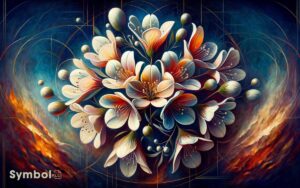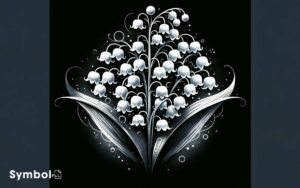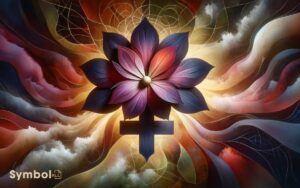Bird of Paradise Flower Symbolism: Beauty, Exoticism!
The Bird of Paradise flower, originating from South Africa and thriving in subtropical climates, symbolizes a fusion of beauty and exoticism.
Its vibrant colors and unique shape reflect the richness and diversity of life, mimicking a bird in flight. This symbolism extends to joy, paradise, freedom, and an unchained spirit.
Scientifically known as Strelitzia reginae, it also represents royal power and divine favor, hinting at a status of high regard.
In spiritual and cultural contexts, it signifies the soul’s ascent to heaven, enlightenment, and a perfect world. Exploring its meanings reveals layers of complexity and beauty, inviting a closer examination.

Key Takeaways
The Origin Story
The origin of the Bird of Paradise flower traces back to South Africa, where it thrives in the wild, symbolizing beauty and exoticism through its vivid colors and unique shape.
Scientifically known as Strelitzia reginae, this perennial plant flourishes in subtropical climates, showcasing its striking resemblance to a bird in flight.
Its distinct morphology, characterized by bright orange and blue hues, serves not only as a visual spectacle but also plays a vital role in its pollination strategies.
The flower’s architecture is specifically designed to facilitate bird pollination, with its sturdy spathe providing an ideal platform for birds to land on, ensuring the transfer of pollen.
This evolutionary adaptation highlights the flower’s intricate relationship with its natural habitat, further cementing its status as a symbol of natural wonder and scientific fascination.
Symbol of Paradise
Embodying the quintessence of a paradisiacal domain, the Bird of Paradise flower signifies not just earthly beauty, but a complex symbol of utopia and fecundity in nature.
This remarkable plant, with its vibrant colors and unique shape, serves as a metaphor for an idealized, flourishing environment where life thrives in harmony.
To deepen your understanding, consider these aspects:
- Vibrant Colors: Symbolizing the richness and diversity of life, inviting a sense of wonder and exploration.
- Unique Shape: Mimicking a bird in flight, it represents the unattainable perfection of nature’s design.
- Tropical Origin: Native to South Africa, it embodies the lush, untamed wilderness often associated with paradise.
Through these characteristics, the Bird of Paradise flower articulates a narrative of abundance, diversity, and ecological balance, encapsulating the vision of a perfect world.
Emblem of Freedom
Shifting focus to its representation as an Emblem of Freedom, you’ll find the Bird of Paradise flower embodies liberation, with its expansive petals and skyward stance reflecting an unchained spirit.
This unique floral specimen, Strelitzia reginae, exhibits vibrant colors and a form that suggests movement and escape. Its resemblance to a bird in flight not only gives it its name but also symbolizes the essence of freedom.
Scientifically, the plant’s architecture, featuring long, sturdy stalks and distinct foliage, supports its lofty blooms, enabling them to stand prominently, as if poised for takeoff.
This structural design not only contributes to its aesthetic appeal but also represents resilience and the ability to rise above constraints, emphasizing its role as a natural emblem of freedom and unbridled potential.
The Joy Connection
You’ll find that the Bird of Paradise flower embodies an essence of emotional upliftment, markedly impacting your mood.
Its radiant colors play a critical role in stimulating happy moods, scientifically linked to color psychology‘s influence on human emotion.
Cultivating spaces with these flowers can lead to a more joyful environment, showcasing their potential to enhance well-being.
Emotional Upliftment Essence
The Bird of Paradise flower serves as a potent symbol for emotional upliftment, connecting individuals to a profound sense of joy through its vibrant colors and unique shape.
This remarkable flora embodies resilience and beauty, thriving in diverse environments while maintaining its striking appearance. Its ability to evoke happiness isn’t merely anecdotal; it’s deeply rooted in its symbolic representation of freedom and creativity.
Consider these aspects:
- Neurological Impact: Studies suggest that viewing complex, colorful patterns can stimulate the brain, enhancing mood.
- Symbolic Representation: Symbolizing joy and paradise, it encourages an optimistic outlook.
- Aesthetic Appeal: Its unique form and vibrant hues can significantly influence one’s emotional state, promoting feelings of well-being and happiness.
Radiant Colors, Happy Moods
Exploring the Bird of Paradise flower‘s vibrant colors uncovers an intriguing link to improved mood states, grounded in scientific evidence. You’ll discover that the vivid hues of orange, blue, and purple not only capture the eye but also play a significant role in emotional well-being.
Research has demonstrated that exposure to bright, saturated colors can activate areas of the brain linked to pleasure and reward, resulting in feelings of happiness and optimism.
This response is part of the brain’s inherent reaction to aesthetically pleasing stimuli, suggesting that the Bird of Paradise’s colors can effectively enhance one’s mood.
Moreover, the flower’s unique color combination may boost cognitive functions by heightening alertness and creativity, making it a natural catalyst for joy.
Cultivating Joyful Spaces
Incorporating the Bird of Paradise flower into your environment can greatly enhance mood and creativity by leveraging its vibrant colors and unique aesthetic appeal. The presence of this exotic flower induces a psychological state conducive to joy and innovation.
Scientific studies suggest that visual exposure to natural beauty, such as that of the Bird of Paradise, can elevate serotonin levels, promoting a sense of well-being.
- Color Psychology: The bright orange and blue hues of the flower stimulate areas of the brain associated with happiness and creativity.
- Spatial Harmony: Integrating the flower into living spaces can create a visually harmonious environment that encourages relaxation and thought clarity.
- Aesthetic Value: Its unique shape and form add an artistic element to spaces, fostering an atmosphere where joy and creativity flourish.
Royal Associations
As you explore the Bird of Paradise flower’s symbolism within royal contexts, it’s essential to understand its role as a monarchical emblem.
The flower’s vibrant hues aren’t merely aesthetic; they carry deep regal color symbolism, reflecting status and power.
Analyzing these aspects provides insight into its esteemed position in royal iconography and ceremonies.
Monarchical Emblem Significance
The Bird of Paradise flower serves as a striking emblem within various monarchies, symbolizing royal power and divine favor with its regal appearance and vibrant colors. This plant’s association with royalty isn’t merely aesthetic but deeply rooted in historical and cultural significance.
- Symbol of High Status: Traditionally, only the nobility had access to exotic plants like the Bird of Paradise, making it a status symbol.
- Representation in Art and Heraldry: Frequently depicted in royal coats of arms and tapestries, it signifies a connection to the divine right of kings.
- Incorporation in Royal Gardens: Its presence in royal botanical collections underscores a fascination with its exotic beauty and a desire to harness its symbolisms of power and prosperity.
Understanding these aspects offers deeper insight into its enduring appeal in royal symbolism.
Regal Color Symbolism
Moving beyond the physical attributes and historical ties of the Bird of Paradise flower, let’s examine how its vivid colors contribute to its symbolism in royal contexts.
The intense hues of this flower, particularly the bright blues and striking oranges, aren’t merely enchanting to the eye; they carry deep symbolic meanings in royal iconography.
Blue often represents serenity, wisdom, and stability, qualities highly valued in a sovereign context. Orange, on the other hand, exudes warmth, enthusiasm, and boundless energy, traits admired in leadership.
When these colors combine in the Bird of Paradise, they create a visual metaphor for ideal governance, embodying both the calm deliberation and the dynamic vigor necessary for rulership.
This duality enhances the flower’s appeal as a regal emblem, reinforcing its association with nobility and excellence.
Spiritual Significance
Delving into the Bird of Paradise flower’s spiritual significance reveals its representation as a symbol of divine beauty and enlightenment in various cultures.
This exotic bloom, with its striking appearance, carries profound spiritual meanings that resonate with many:
- Divine Connection: Its resemblance to a bird in flight symbolizes the soul’s ascent to heaven, highlighting a spiritual journey towards understanding and divine connection.
- Illumination: The vibrant colors and unique shape signify enlightenment, suggesting an awakening of the mind and spirit to higher knowledge.
- Rebirth and Renewal: Mirroring the cycle of life, death, and rebirth, this flower embodies transformation and the continual renewal of the spirit.
Understanding these spiritual dimensions provides a deeper appreciation of the Bird of Paradise as more than just a visual marvel, but as a significant emblem in spiritual exploration.
Cultural Interpretations
Exploring the Bird of Paradise flower‘s cultural interpretations reveals its multifaceted significance across different societies, reflecting a rich tapestry of meanings and associations.
In South Africa, where it originates, it symbolizes joy and paradise itself, mirroring the region’s biodiverse richness and vibrant landscapes.
Its resemblance to a bird in flight has led to its association with freedom and creativity, inspiring artists and thinkers globally.
Scientifically known as Strelitzia, this flower’s vivid colors and unique shape have made it a symbol of exoticism and rarity, often used in ceremonies and celebrations to denote prestige and a sense of the extraordinary.
Additionally, its resilience and ability to thrive in diverse climates have made it a symbol of adaptation and survival, resonating with cultures that value persistence and strength.
Love and Fertility
You’ll find that the Bird of Paradise flower holds intricate layers of symbolism related to love and fertility, which are deeply embedded in various cultures. Its vivid colors and unique shape often represent romantic love, signaling a partner’s attraction and commitment.
Additionally, the plant’s robust growth and flourishing blooms are scientifically associated with fertility, offering a potent symbol for reproduction and the continuation of life.
Symbolic Love Meanings
The Bird of Paradise flower embodies profound symbols of love and fertility, resonating deeply with cultural narratives that celebrate these aspects of human experience.
This exotic plant isn’t just a visual spectacle; its unique structure and vibrant colors contribute to its symbolic representation of love.
Here are three key aspects to ponder:
- Vivid Colors: The intense hues symbolize the passion and energy in a loving relationship.
- Unique Structure: Its distinctive shape resembles a bird in flight, symbolizing freedom and joy within love.
- Rare Beauty: The rarity and exotic nature of the flower reflect the unique and precious nature of love.
Understanding these symbols enhances your appreciation for the Bird of Paradise as more than just a decorative plant, but as a profound emblem of love’s complexity and vibrancy.
Fertility Representations
Building on its symbolism of love, the Bird of Paradise flower also embodies powerful representations of fertility, intertwining these concepts in cultural narratives.
Its vibrant colors and unique shape aren’t just visually striking; they play a significant role in symbolizing creation and reproduction.
Scientifically speaking, the flower’s structure, which facilitates the attraction of pollinators, mirrors the essence of fertility. It’s a living metaphor for the process of pollination, an essential act for the continuation of many plant species.
This botanical marvel’s fertility symbolism doesn’t stand in isolation; it’s a part of a broader ecological narrative that underscores the interconnectedness of love, life, and regeneration.
Hence, within the context of symbolism, the Bird of Paradise flower serves as a poignant reminder of nature’s cycles of renewal and the intrinsic value of fertility.
Cultural Love Beliefs
Across various cultures, the Bird of Paradise flower symbolizes a profound connection between love and fertility, deeply rooted in traditions and beliefs that highlight its significance in rituals and storytelling.
This exotic bloom isn’t just a feast for the eyes; it’s a symbol steeped in meaning, conveying messages of good fortune, vibrant love, and abundant procreation.
In examining its role, you’ll find:
- Ceremonial use in weddings: to signify the start of a fruitful union.
- Gifts between lovers: symbolizing a deep, passionate connection.
- Decor in fertility rituals: believed to attract positive energies to aid conception.
Understanding the Bird of Paradise flower’s symbolism offers insight into how nature’s beauty is intertwined with human culture, expressing love and the hope for new beginnings.
Artistic Inspirations
Drawing inspiration from its striking appearance, artists have often incorporated the Bird of Paradise flower into their works, exploring its complex symbolism through various mediums.
The flower’s vivid colors and unique shape not only captivate the visual senses but also serve as a potent metaphor for exotic beauty, freedom, and the quest for paradise.
In paintings, the Bird of Paradise has been meticulously depicted with an emphasis on its intricate details, highlighting the interplay of colors and shapes that make this flower so distinctive.
Similarly, in sculpture, its form has been abstracted to capture the essence of its beauty, challenging viewers to contemplate its broader symbolism.
This artistic fascination underscores a deep appreciation for nature’s artistry, inviting a closer examination of the flower’s role in symbolizing human aspirations and desires.
Modern Uses
In contemporary contexts, the Bird of Paradise flower serves various practical purposes, ranging from ornamental horticulture to its symbolic presence in cultural events. You’ll find its applications both fascinating and diverse.
- Ornamental Horticulture: Cultivated widely for its striking appearance, the Bird of Paradise is a staple in tropical and subtropical gardens. Its unique structure and vibrant colors make it a focal point in landscape design.
- Floral Arrangements: Due to its exotic and durable nature, it’s a popular choice for bouquets and floral displays, symbolizing freedom and joy.
- Cultural Symbolism: It holds significant meaning in various cultures, often representing paradise, beauty, and the exotic. Its usage in ceremonies and festivals underscores its symbolic importance.
Analyzing these uses reveals the multifaceted roles this flower plays in modern society, from aesthetic enhancement to deep cultural significance.
Conservation Efforts
Numerous conservation efforts are underway to protect the Bird of Paradise flower. These efforts focus on habitat preservation and sustainable cultivation practices.
Researchers are mapping out critical habitats and identifying areas under threat from urban expansion and invasive species. They are deploying advanced conservation techniques such as in-situ and ex-situ conservation to guarantee the survival of this species.
In-situ efforts involve protecting the flower in its natural habitat, while ex-situ strategies include cultivating the Bird of Paradise in botanical gardens and seed banks.
These measures are essential for maintaining genetic diversity and facilitating restoration projects. Additionally, local communities are being educated on the importance of this plant, promoting eco-tourism as a sustainable alternative to exploitation.
Through these multidimensional approaches, conservationists aim to secure the future of the Bird of Paradise flower in the face of escalating environmental challenges.
Conclusion
In your journey through the domains of symbolism, you’ve witnessed the bird of paradise flower bloom into a myriad of meanings.
Its petals stretch like wings towards the sun, embodying paradise, freedom, and joy in a delicate balance. Royal in its stance, it whispers tales of love and fertility, inspiring artists and conservationists alike.
As you ponder its scientific marvel, remember, it’s not just a plant but a living allegory, thriving at the intersection of nature’s artistry and human interpretation.






